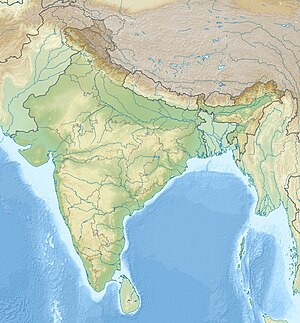Asirgarh Fort
This article needs additional citations for verification. (June 2015) |
| Asirgarh Fort | |
|---|---|
| Part of Madhya Pradesh, | |
| Burhanpur, District Burhanpur, Madhya Pradesh, India[1] | |
 Asirgarh Fort in 2013 | |
| Coordinates | 21°28′N 76°17′E / 21.47°N 76.29°E |
| Type | Hill fort |
| Site information | |
| Owner | Government of India |
| Open to the public | yes |
| Condition | dilapidated |
| Site history | |
| Built by | Asa Ahir |
| Materials | Stone, Limestone and Lead |
| Garrison information | |
| Occupants | Faruqi dynasty->Mughal->Maratha->Holkars->Shinde->British |
Asirgarh Fort is an Indian fortress (qila) situated in the Satpura Range about 20 kilometres (12 mi) north of the city of Burhanpur, in the Indian state of Madhya Pradesh. The Asirgarh fort is said to have been built by a rich herdsman named Asa Ahir[2][3] in the early 15th century because the fortress commands a pass through the Satpuras connecting the valleys of the Narmada and Tapti rivers, one of the most important routes from northern India to the Deccan, it was known as the "key to the Deccan".[4][5]
History
[edit]
The Asirgarh fort is said to have been built by a herdsman named Asa Ahir in the early 15th century.[6] He was murdered by Sultan Nasir Khan of Khandesh and was considered as one of the seven unconquerable forts of India. Faroqis ruled over Khandesh from Asirgarh for more than two centuries.[7][8]
Nasir Khan's descendant Sultan Bahadur Shah (1596–1600) declared his independence and refused to pay homage to the Mughal emperor Akbar and his son Daniyal. Akbar marched towards Burhanpur in 1599 and occupied the city. Akbar then besieged Asirgarh fort and captured it on 17 January 1601 by tricking Bahadur Shah.[9]
During the Second Anglo-Maratha War, on 18 October 1803, Company forces took the pettah of Asigarh with a loss of two killed and five wounded. The fort's garrison subsequently surrendered on the 21st after the attackers had erected a battery.[10]
Toward the end of the Third Anglo-Maratha War in early 1819, most Maratha forts had been captured by the British, with the lone holdout being Asirgarh Fort, which was under the command of qiladar Jeswant Rao Lar. In March of that year, a massive British contingent laid siege to Asirgarh, capturing and occupying the town next to the fort to serve as a temporary base of operations. The 1,200-strong garrison was subject to constant artillery bombardments before the British launched an assault, which led to the fort's capture on 9 April. With the capture of Asirgarh Fort, the British victory in the conflict was complete and all military operations ceased.[11][12]
Architecture
[edit]The architecture of the fort is mainly influenced by the Indian architecture, some parts also show Faroqi and Mughal architecture, an amalgamation of Islamic, Persian, Turkish and Indian styles. There are three man made ponds to provide a water supply.
There is a temple known as Gupteshwar Mahadev Mandir, dedicated to the Hindu deity Shiva. There is a local legend that Ashwatthama, a character in the Indian epic Mahābhārata, used to come to this temple to worship and offer flowers each morning to Lord Shiva.
There is a ruined mosque of faroqi era with minarets known as Asir Masjid inside the Fort. Apart from the Hindu and Muslim architecture, some ruins are of British origin and there are also British graves. This fort has been deserted following the departure of the British.
References
[edit]- ^ "District Burhanpur". Government of Madhya Pradesh, India. 2023. Retrieved 19 October 2023.
- ^ Hunter, William Wilson (1889). England's Work in India. Christian Vernacular Education Society: S.P.C.K. Press, Vepery.
- ^ Willcocks, Sir James (1904). From Kabul to Kumassi: Twenty-four Years of Soldiering and Sport. John Murray.
- ^ Sarkar, Sir Jadunath (1957). Sir Jadunath Sarkar Commemoration Volumes: Life or letters of Sir Jadunath Sarkar. Department of History, Panjab University.
- ^ Indian History Congress. 1951.
- ^ Michell, George; Davies, Philip H. (1989). The Penguin Guide to the Monuments of India: Islamic, Rajput, European. Viking. ISBN 978-0-670-80847-2.
- ^ Mehta, Behram H. (1984). Gonds of the Central Indian Highlands: A Study of the Dynamics of Gond Society. Vol. 2. New Delhi: Concept Publishing Company. p. 569.
- ^ Jha, Amiteshwar; Garg, Sanjay, eds. (2003). "Untitled". Numismatic Digest. 25–26 (2001–2002). Numismatic Society of Bombay: 141.
- ^ Sen, Sailendra (2013). A Textbook of Medieval Indian History. Primus. p. 164. ISBN 9789380607344.
- ^ Burton, Reginald George (1908). Wellington's Campaigns in India. Calcutta: Superintendent Government Printing, India. pp. 67–68. ISBN 9780979617461.
- ^ Cannon, Richard (1849). Historical Record of the 67th Foot. London: Parker, Furnivall & Parker.
- ^ Burton, Reginald George (1910). The Mahratta and Pindari War. Simla: Government Press.
External links
[edit]- Haunted Fort of Asirgarh – Truth Revealed (video on YouTube)
- Asirgarh Fort. Archived 4 August 2017 at the Wayback Machine.
- असीरगढ किला, खंडवा (in Hindi)

